Building a professional VR space costs between $50,000 and $250,000 depending on your setup. You’ll need high-end headsets like the HTC Vive Pro 2 ($1,400) or Varjo VR-3 ($3,200), VR-ready PCs ($1,500-$3,000), tracking sensors ($100-$300 each), audio equipment ($100-$1,000), and climate control systems ($1,000-$5,000). Don’t forget cable management ($200-$500) and annual maintenance costs of 15-20% of your equipment budget. The following breakdown reveals exactly what you’ll spend on each component.
Room-Scale VR Hardware Requirements and Pricing
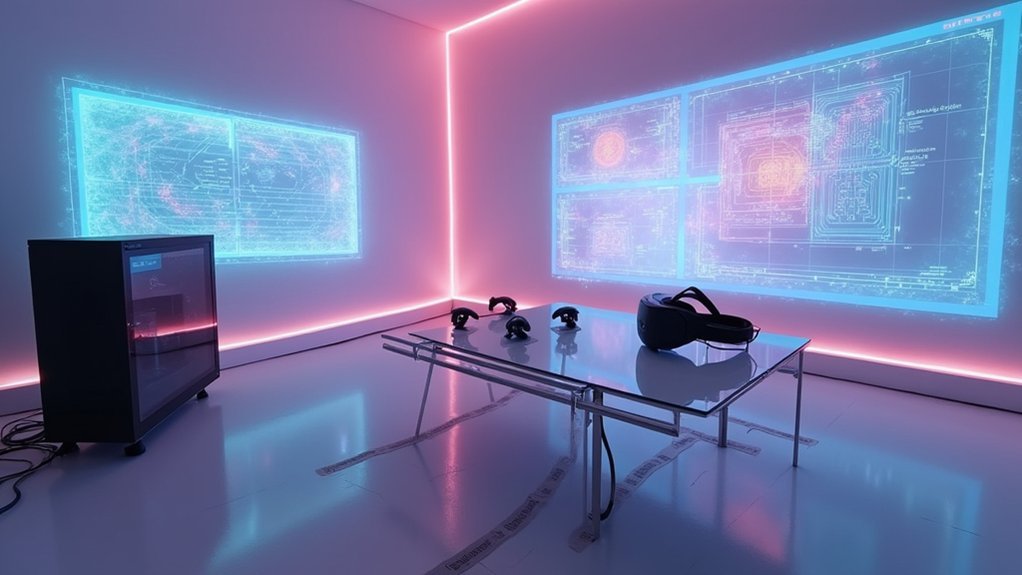
When you’re considering room-scale VR, you’ll need to budget for significant hardware investments that extend far beyond just the headset.
High-end VR systems like the HTC Vive Pro 2 cost around $1,400 for the headset alone. You’ll also need a VR-ready PC ranging from $1,500 to $3,000 to power your experiences effectively.
Premium VR headsets start at $1,400, but you’ll need an additional $1,500-$3,000 VR-ready PC to run them properly.
Tracking accessories add another $100 to $300 to your hardware costs, providing the external sensors necessary for accurate movement detection.
For peak performance, you’ll want systems capable of 120 fps to minimize motion sickness and enhance comfort.
Your complete VR setup can easily exceed $5,000 when factoring in all necessary components, software licenses, and accessories required for a professional-grade room-scale VR experience.
Professional VR Headset Options and Specifications
When you’re building a professional VR space, you’ll need to evaluate enterprise-grade headsets that deliver the technical specifications your applications demand.
Your choice between models like the Varjo VR-3, HTC Vive Pro 2, and Valve Index will depend on specific performance features such as resolution, tracking capabilities, and refresh rates.
You’ll want to compare how each headset’s technical specifications align with your professional requirements and budget constraints.
Enterprise VR Headset Models
As enterprise VR adoption accelerates across industries, you’ll find professional headset models that deliver markedly higher performance than consumer alternatives.
Enterprise VR headset models like the Varjo VR-3 lead with industry-standard resolution and eye tracking at $3,200, perfect for applications demanding high fidelity visuals. The HTC Vive Pro 2 costs around $1,400 but requires additional accessories, bringing total setup costs over $2,000.
Meanwhile, the Valve Index offers high-performance gaming capabilities at $999 for headset and controllers. These professional VR headsets feature advanced specifications including 120+ fps refresh rates for enhanced immersion.
Tracking technologies vary considerably—HTC Vive uses external base stations for precision, while Meta Quest incorporates inside-out tracking for simplified deployment and mobility.
Technical Specifications Comparison
Beyond model selection, understanding detailed technical specifications helps you make informed decisions about which professional VR headset best matches your specific requirements. When comparing VR headsets, resolution and refresh rates directly impact your immersive experiences.
| Headset Model | Resolution Per Eye |
|---|---|
| Oculus Quest 2 | 1832 x 1920 |
| Valve Index | 1440 x 1600 |
| HP Reverb G2 | 2160 x 2160 |
| HTC Vive Pro 2 | 2448 x 2448 |
The HP Reverb G2 delivers exceptional clarity at $599, while the HTC Vive Pro 2 offers the highest resolution at $1,400. The Valve Index balances performance with its 144 Hz refresh rate capability. For enterprise applications, the Varjo VR-3’s advanced eye tracking justifies its $3,200 price point, providing unmatched professional-grade technical specifications.
Professional Performance Features
Professional VR headsets distinguish themselves through advanced performance features that justify their premium pricing for enterprise and specialized applications.
You’ll find that high-quality VR systems like the Varjo VR-3 deliver industry-leading resolution and eye tracking capabilities, essential for immersive VR experiences in professional environments. These VR headsets typically include external tracking systems that provide superior positional accuracy compared to consumer alternatives.
However, you’ll need to factor in significant development costs beyond the headset price. The HTC Vive Pro 2 requires a powerful VR-ready PC and additional accessories, pushing total investment over $2,000.
Mid-range options like the HP Reverb G2 offer professional-grade visuals at $599, though they still demand robust computing hardware with recommended AMD graphics cards featuring LiquidVR interface optimization.
High-Performance Computing Systems for VR
Several key components determine whether your computing system can deliver the immersive VR experience you’re seeking. High-performance computing systems for VR typically range from $1,500 to $3,000, depending on your specifications.
Your VR-ready PC needs advanced graphics cards, preferably AMD with LiquidVR interface, plus at least 16GB RAM and fast processors for complex rendering tasks.
Advanced graphics cards with LiquidVR interface, 16GB RAM minimum, and high-speed processors form the foundation of any VR-ready gaming system.
You’ll want to target performance metrics of 72-144 FPS to prevent VR sickness and guarantee smooth gameplay. These specifications handle demanding rendering requirements that VR applications demand.
Don’t forget about ongoing costs – regular maintenance keeps your system running effectively, while upgrades every 2-3 years maintain peak performance.
Budget for component replacements and enhancements to sustain your high-quality VR experience long-term.
Tracking Systems and Motion Sensors Installation
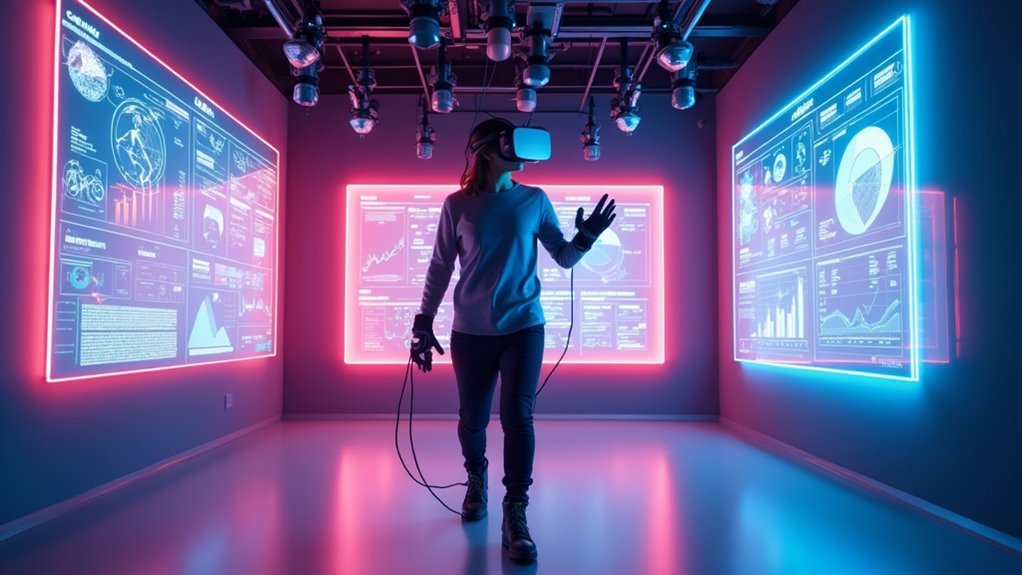
You’ll need to budget between $100 to $300 per motion sensor unit when planning your VR space installation.
Your choice between outside-in systems like HTC Vive or inside-out systems like Meta Quest will greatly impact both your hardware costs and setup complexity.
Consider that proper motion tracking hardware requires strategic placement to eliminate dead zones while maintaining the 120 fps refresh rates essential for preventing VR sickness.
Sensor Installation Costs
When setting up your VR space, tracking system and motion sensor installation costs can quickly become a substantial portion of your budget. Individual sensors typically cost $100-$300, but VR setups requiring multiple base stations can escalate expenses dramatically.
| System Type | Cost Range | Professional Installation |
|---|---|---|
| Basic sensors | $100-$300 | $50-$150/hour |
| HTC Vive base stations | $300-$600 | $100-$300 total |
| Advanced optical systems | $1,000-$5,000+ | $200-$500 total |
| Multi-room tracking | $2,000-$8,000 | $500-$1,500 total |
| Commercial setups | $5,000-$15,000+ | $1,000-$3,000 total |
Advanced optical positioning systems add thousands to installation expenses but deliver exceptional tracking accuracy. Professional installation services charge hourly rates, making complex projects costly. Don’t forget maintenance costs—budget 10-15% annually of initial installation expenses to guarantee ideal performance of your tracking systems.
Motion Tracking Hardware
Motion tracking hardware forms the backbone of any immersive VR experience, directly impacting how accurately your movements translate into the virtual world.
You’ll choose between outside-in systems like HTC Vive requiring external sensors, or inside-out tracking like Meta Quest with built-in cameras. Installation costs range from $100 to $300 depending on your setup’s complexity.
High-performance tracking demands 120 fps refresh rates to minimize latency and motion sickness. Proper calibration guarantees peak accuracy, while strategic sensor placement prevents obstacles and maintains safety.
You can’t overlook regular maintenance – routine hardware checks and recalibration prevent tracking errors and equipment failure. Your investment in quality motion tracking hardware directly determines your VR space’s responsiveness and immersion levels.
Audio Equipment and Spatial Sound Solutions
While visual fidelity often captures the spotlight in VR discussions, spatial sound serves as the invisible foundation that transforms good virtual experiences into truly immersive ones. Your audio equipment investment directly impacts realism, with costs ranging from $100 to $1,000 depending on your chosen headphones, speakers, and microphones.
| Audio Solution | Cost Range |
|---|---|
| Basic Headphones | $100-$300 |
| Premium Audio Setup | $500-$1,000 |
| Haptic Feedback Systems | $300-$1,500 |
| 3D Audio Engines | Free-$200 |
| Annual Maintenance | 10-15% of total |
Implementing 3D audio engines like Steam Audio enhances spatial positioning without breaking budgets. Haptic feedback systems complement audio for deeper immersion. Regular maintenance guarantees peak performance—budget 10-15% of total audio expenses for upkeep and calibration.
Safety Equipment and Room Preparation Costs
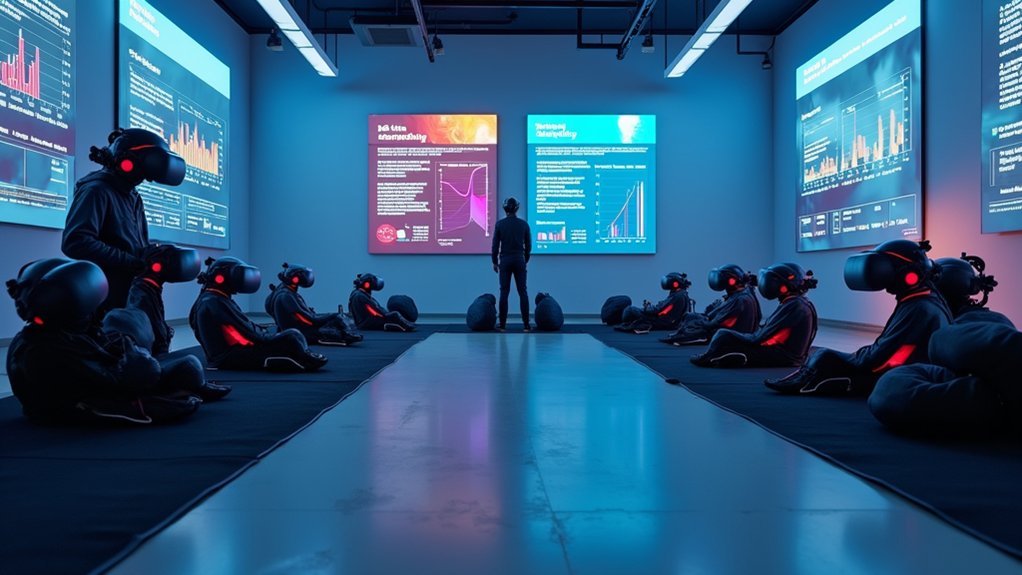
You’ll need to invest in essential safety gear like VR mats and barriers, which typically add $50 to $200 to your initial setup costs.
Your room setup requirements go beyond equipment – you’ll face potential renovation expenses for proper layout planning and obstacle removal to prevent tripping hazards.
Cable management systems become vital for user safety, requiring an additional $200 to $500 investment depending on your installation’s complexity.
Essential Safety Gear
When setting up your VR space, investing in essential safety gear becomes paramount to preventing injuries and guaranteeing smooth gameplay experiences.
You’ll need VR mats costing $50-$200 to enhance spatial awareness and prevent falls. Clear your room of obstacles and establish marked safety zones for accident prevention.
Effective cable management solutions ranging from $20-$100 will eliminate tripping hazards in your setup. Your room dimensions should be at least 10×10 feet to allow safe movement during VR activities.
Don’t forget proper ventilation to maintain comfort during extended sessions.
For your annual budget, allocate approximately 10% of total safety equipment costs for maintenance, replacements, and upgrades. This guarantees your safety gear remains effective and reliable throughout the year.
Room Setup Requirements
Beyond acquiring safety gear, transforming your room into a VR-ready space demands careful attention to layout, equipment positioning, and protective installations.
You’ll need to establish clear safety zones that provide adequate movement space for immersive VR experiences while preventing collisions with obstacles. Effective cable management systems are essential to eliminate tripping hazards, though costs vary based on complexity.
Installing tracking sensors or cameras for accurate movement capture typically runs $100-$300 for external systems. Wall and corner padding helps mitigate injury risks, with expenses depending on materials chosen.
Planning smooth customer entry and exit flows enhances both safety and user experience, though this careful room setup planning may require additional design costs for peak functionality.
Cable Management and Power Infrastructure
How can you transform a potentially hazardous tangle of wires into a sleek, professional VR environment? Effective cable management begins with cable organizers and clips that keep wires accessible yet out of your way.
You’ll need robust power infrastructure featuring sufficient outlets and surge protectors, as VR systems demand reliable power sources to prevent disruptions during gameplay.
Cable trays and raceways streamline routing along walls and ceilings, reducing clutter while enhancing aesthetics. Regular cable inspection prevents wear that could lead to equipment failure, extending your system’s longevity.
Consider wireless charging solutions for controllers and headsets to minimize cable use entirely.
This strategic approach creates a safer gaming environment while considerably improving user experience through reduced tripping hazards and visual distractions.
Ventilation and Climate Control Systems
A well-organized cable system sets the foundation for your VR space, but proper ventilation and climate control will make or break your users’ experience. You’ll need to maintain temperatures between 68°F and 72°F to prevent equipment malfunctions while guaranteeing user comfort during extended sessions.
Strategic air circulation prevents overheating and reduces customer complaints about stuffy environments. Installing circulation fans improves airflow and heat dissipation, directly impacting customer satisfaction.
| System Component | Initial Installation Costs | Monthly Ongoing Expenses |
|---|---|---|
| Basic Ventilation | $1,000 – $2,500 | $50 – $100 |
| Advanced Climate Control | $2,500 – $5,000 | $100 – $200 |
| Air Circulation Fans | $200 – $800 | $15 – $30 |
| Maintenance Services | $0 | $75 – $150 |
Regular maintenance prevents costly downtime and guarantees consistent performance that keeps customers returning.
Maintenance and Warranty Coverage Plans
While proper ventilation keeps your VR space comfortable, establishing detailed maintenance and warranty coverage plans protects your investment from unexpected failures and costly repairs.
You’ll need to allocate 15-20% of your original VR equipment budget annually for maintenance to meet operational needs. Regular upkeep includes sanitizing devices, testing functionality, and installing software updates.
Standard warranty coverage typically lasts one year, but you can purchase extended protection through manufacturer service agreements. These plans cover repairs and replacements beyond basic terms, though they won’t protect against user negligence or certain accessories.
Before buying, review warranty specifics carefully since coverage varies greatly between manufacturers. Consider maintenance packages that bundle routine care with repair services for thorough protection.
ROI Analysis for Different VR Space Configurations
Beyond protecting your equipment investment through maintenance plans, you’ll want to evaluate the financial returns different VR space configurations can generate.
Your initial investment costs typically range from $50,000 to $250,000, directly influencing your VR business profitability based on space size and equipment choices.
Space size and equipment quality directly determine your initial investment range of $50,000 to $250,000 and long-term profitability potential.
Smaller venues offer compelling advantages for ROI analysis, reducing rental expenses by 40% and creating faster payback periods.
You’ll need to factor long-term operational costs into your project budgets, including 15-20% annually for maintenance and $5,000-$20,000 per licensed game title.
Effective marketing strategies requiring 10-15% of startup capital drive customer acquisition essential for positive returns.
Understanding customer preferences helps optimize your configuration choice, whether you prioritize premium equipment or cost-effective setups that maximize revenue potential.
Frequently Asked Questions
What Is the Best Amount of Space for VR?
You’ll need at least 10×10 feet for room-scale VR, but 30×30 feet works best for free-roam experiences. Don’t forget 8-10 foot ceilings and 6-foot spacing between stations.
What’s the Best VR Money Can Buy?
You’ll find the Varjo VR-3 offers the best VR money can buy at $3,200, featuring industry-leading resolution and precise eye tracking that’s unmatched for professional applications and demanding experiences.
Is VR Ok for the Brain?
VR’s generally safe for your brain when you use it moderately. You’ll experience enhanced learning and spatial awareness, but prolonged sessions can cause motion sickness and eye strain, so take regular breaks.
How Much Does a Virtual Reality System Cost?
You’ll spend $300-$600 for entry-level VR systems, $800-$1,500 for mid-range setups, or over $2,000 for high-end configurations. Don’t forget you’ll need a VR-ready computer costing $1,500-$3,000 plus additional accessories.
In Summary
You’ve seen the complete breakdown of VR space costs, from basic setups starting at $5,000 to premium installations reaching $50,000+. You’ll need to balance your budget against performance requirements, considering ongoing maintenance costs that typically run 10-15% annually. Don’t forget you’re investing in future-ready technology that’ll deliver strong ROI through increased engagement and revenue streams. Choose the configuration that matches your space, audience, and long-term business goals.

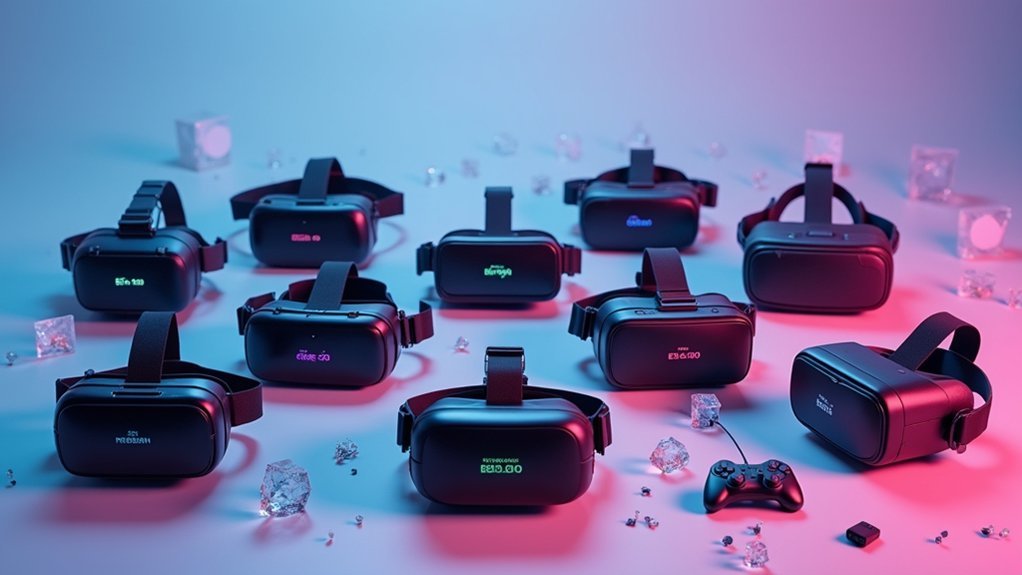

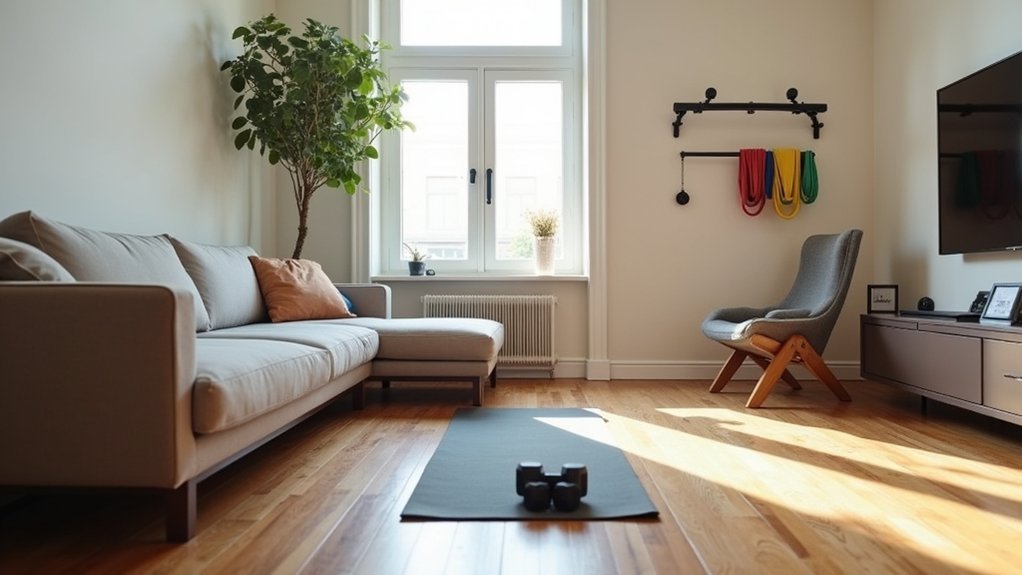
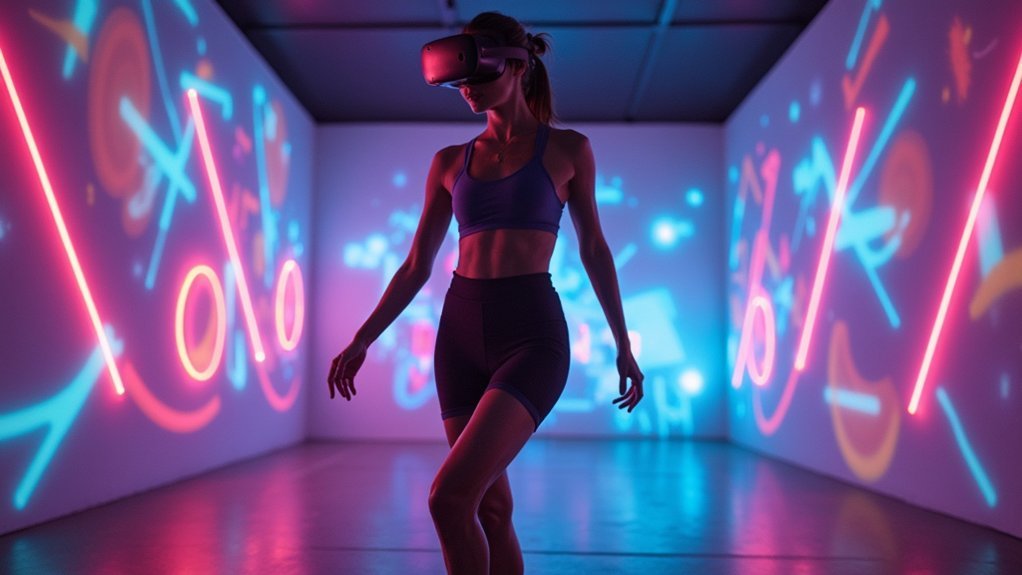
Leave a Reply